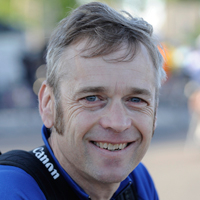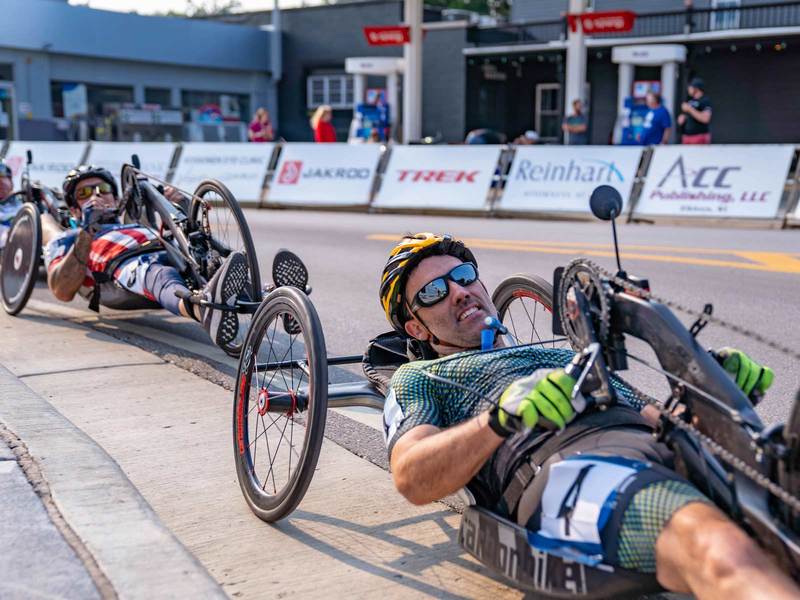Mike Magnuson, a biker and author from Appleton, has documented the divisions among cyclists in a book called "Bike Tribes: A Field Guide to North American Cyclists."
As Magnuson humorously describes it, cycling is a sport of separate clubs: from spandex-clad racers to tweed-clad vintage bike aficionados.
Those divides are conquered every fall, when the cyclocross season brings smooth-legged roadies, tattooed hipsters and rugged mountain bikers together for their kumbaya moments, fueled by oxygen debt and beer.
Fast and furious, often dirty, cyclocross has been the fastest growing form of bike racing in the country. Participation more than doubled from 32,000 racers to 72,000 from 2005 to 2010, according to USA Cycling.
The Wisconsin Cycling Association's 15-race series has been part of the boom, helping the Midwest keep pace with the northwest, mountain states and northeast among the regions warmly embracing the cold-weather variation of bike racing.
Wisconsin and the WCA has been successful in producing riders who compete with great success on the national scene, including national U23 and collegiate champion Katie Antonneau, Sam and Skylar Schneider, Ian Haupt, Corrie Osborne, Diane Ostenso and Brian Matter.
When the WCA series started 16 years ago, it offered five races, and organizers celebrated if 100 people showed up. Some race categories, particularly, the novice and female divisions, drew fewer than 10 competitors.
On Saturday, in Mitchell Park on Milwaukee's South Side, organizers expect 350 to line up and race in the third annual Cross the Domes, the fourth race in the WCA Series. The masters fields, for racers 35 and over, are likely to top out at more than 50 riders.
Cyclocross (or cyclo-cross in some parts of the world) has an appealing irreverence; no less intense but far less intimidating for participants than road races and criteriums. Rather than ride circuits in a large pack, the competitors spread out on the twisting, often hilly dirt courses, and test their bike handling skills negotiating steep descents, tight turns, rocks and tree roots.
Obstacles or steep hills force racers to jump off their bikes and run for short stretches; a ballet of athleticism when executed by the elites, and a clumsy display of ineptitude when bungled by the novices.
Still, as one rider explained, if you fall, you don't lose large patches of skin.
Typically staged in parks, on courses of 1.5 – 2.5 miles, the races are also festive events for spectators, who line the barriers, clang cowbells, drink beer and heckle friends and foes at the most treacherous points. Some of the more popular races in the WCA series, in Washington and Estabrook Park, have the feel of tailgate parties at Miller Park or Lambeau Field.
"The association with beer is legendary," said Dave Eckel, a 45+ rider on Team Wisconsin/KS Energy Services.
That spirit likely followed the sport from its roots in Belgium, France and the Netherlands, where road racers took to the fields in the late fall to extend their season.
The post-race beverages are of the adult variety, but the sport itself grabs the inner child.
"I look at cross, and we are a bunch of boys and girls racing our bikes like we are 10 years old," said Paul Warloski, a member of the MWI Team staging the races in Mitchell Park on Saturday. "This is just me, as a little boy, but almost 50 years old, riding my bike and having a ball doing it, plus there's the physical challenge."
Warloski likened the appeal of cyclocross to that of the Dirty Girl or Tough Mudder races – something incredibly hard, but equally fun.
At 30 minutes long for the novice groups, up to 90 minutes for the pros, the races have the aerobic intensity of a 5K run. Hard-charging competitors like to use the phrase "you'll bleed through your eyelids" to describe the lung-burning cardio exertion.
Kate Konkle, 31, of Madison, described cyclocross as "the most fun you can have while wanting to die."
Konkle, a public health nurse, entered her first cyclocross race last year after spectating at Madison-area races. She showed up at her first practice with a mountain bike and flat, commuter-style pedals. Instead of being mocked as an ill-equipped newbie, she was welcomed and encouraged.
"It's a really fun group of people," she said.
Julie O'Neill, of Shorewood, had a similar experience, but at the other end of the age spectrum. The 65-year-old not only entered her first cyclocross race in 2011, she won her age group and a national championship in race number two, the USA Cycling Cyclo-cross National Championships held in Verona.
"What I had to do was master my terror of racing and master the course," O'Neill said. "I did that and found myself on the podium, which I think should be an inspiration to women of all ages to try something they think is intimidating or challenging.
"Me, with no cycling background, no athletic background, it was an accomplishment just to show up, go to the line and do your best.
"It is hard, and you are suffering, but the folks out there with you are cheering, or heckling you. It's all in a culture that's very open and welcoming. I love the atmosphere."
Madison has maintained a slight lead over Milwaukee in cyclocross support, and Dane County will host the USA Cycling National Cyclo-cross Championships for a second time, Jan. 9-13. The races will be held in Badger Prairie Park and serve as a prelude to the UCI Cyclo-Cross World Championships in Louisville, Ky., Feb. 2 and 3. It will mark the first time the World Championships have been held in the U.S., another indication that the sport has grown up in America.
Jerry Pearce uses another measure: support for the sport and product offerings from large bicycle companies. Pearce owns the Rainbow Jersey shop in Shorewood and helped found the WCA cyclocross series.
In the first few years, nearly everyone competed on mountain bikes. Today, almost everyone races on bikes designed specifically for cross – road-style frames but with narrow, knobby tires, and a slightly longer wheel base.
The bike industry "finally realized there is a market there," Pearce said. "That certainly helped."
The equipment offerings have grown with the sport, but its accessibility and atmosphere have been bigger factors in its growth.
"I remember showing up at a race on a borrowed bike and thinking that this was the coolest thing since sliced bread," said Warloski, a 48-year-old school teacher. "I was pushing myself, with people who love riding their bikes in the mud. The whole atmosphere made me realized that this is what I love."
Memories of running cross-country for the Slinger Owls motivated Tom Held to get his body moving again when he turned 30. Almost two decades later, he's still on the move. The 49-year-old bikes, runs and skis, and covers news for similarly active people as a freelance writer and blogger.
He spent 26 years as a daily news reporter, and applies that experience to dig out stories about athletes, races, endurance sports, fitness and self-propelled transportation. His work has appeared in Silent Sports Magazine, Wisconsin Trails and Cross-Country Skier.
Held lives in the Bay View neighborhood, where he counts being Dad to twin daughters part of his daily workout.





